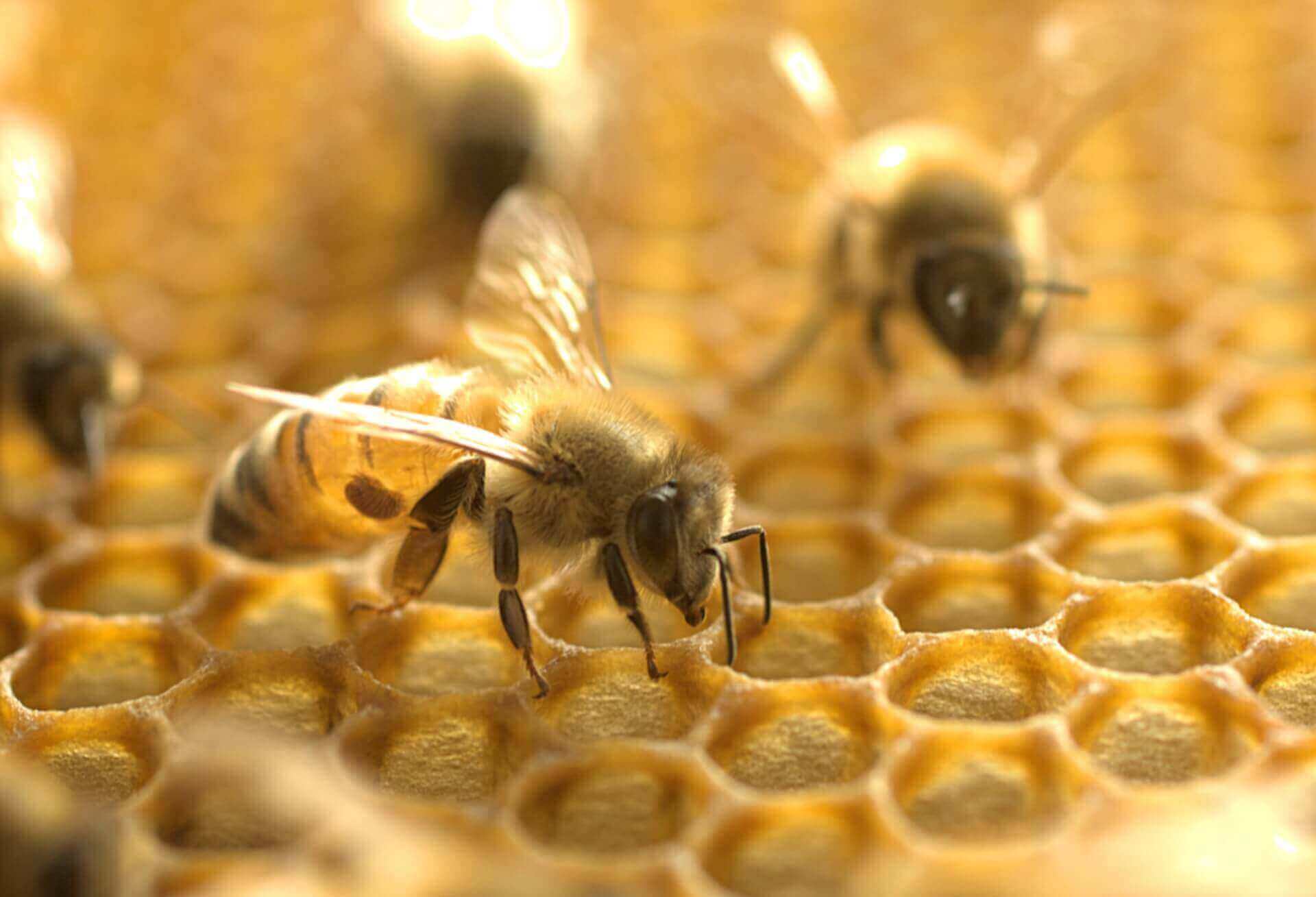Honeybee Facts & Information
The fact is – honeybees are integral to our ecosystem.
HONEYBEES AND THEIR IMPORTANCE

The easiest way to differentiate a honeybee from other types of bees or wasps is to look at the shape of their thorax and abdomen. Honeybees have a distinctive barrel-shaped body and don’t have a thin middle section between the thorax and abdomen like many other insects. Honey bees get their common name from the honey they make using the nectar of flowers. They are social insects found all over the world and are extremely beneficial because of their role in pollination. In the U.S. alone, honeybees pollinate more than 100 crops.
The vast majority of plant species – almost 90% – rely on pollinators like the honeybee to reproduce. Pollination is the process by which pollinators help plants to produce fruit (technically anything with seeds on the inside, so that includes things we normally think of as vegetables like cucumbers, green beans, and tomatoes) by transporting pollen from one flower to another. There are approximately 200,000 different species of animals around the world that act as pollinators. Of these, about 1,000 are vertebrates, such as birds, bats, and small mammals, and the rest are invertebrates, including flies, beetles, butterflies, moths, and bees. Pollinators provide pollination services to over 180,000 different plant species.
Honeybees are among the most numerous and efficient pollinator species in the world. Considering that the average honeybee can visit more than 2,000 flowers in one day, these bees greatly increase the chances of a plant producing a fruit or vegetable. Honeybees are the species most commonly used as commercial pollinators in the US. They are managed and used to pollinate over 100 crops grown in North America, and contribute $15 billion to the US economy every year. Many crops, such as almonds, which contribute $4.8 billion to the US industry each year, rely on honey bees for more than 90% of their pollination. But honeybees don’t only pollinate crops– they also pollinate wild and native plants, thus contributing to all the environmental and societal benefits attributed to pollinators in general above.Not the stinging pest you have?
The vast majority of plant species – almost 90% – rely on pollinators like the honeybee to reproduce. Pollination is the process by which pollinators help plants to produce fruit (technically anything with seeds on the inside, so that includes things we normally think of as vegetables like cucumbers, green beans, and tomatoes) by transporting pollen from one flower to another. There are approximately 200,000 different species of animals around the world that act as pollinators. Of these, about 1,000 are vertebrates, such as birds, bats, and small mammals, and the rest are invertebrates, including flies, beetles, butterflies, moths, and bees. Pollinators provide pollination services to over 180,000 different plant species.
Honeybees are among the most numerous and efficient pollinator species in the world. Considering that the average honeybee can visit more than 2,000 flowers in one day, these bees greatly increase the chances of a plant producing a fruit or vegetable. Honeybees are the species most commonly used as commercial pollinators in the US. They are managed and used to pollinate over 100 crops grown in North America, and contribute $15 billion to the US economy every year. Many crops, such as almonds, which contribute $4.8 billion to the US industry each year, rely on honey bees for more than 90% of their pollination. But honeybees don’t only pollinate crops– they also pollinate wild and native plants, thus contributing to all the environmental and societal benefits attributed to pollinators in general above.Not the stinging pest you have?
Where Do Honeybees Live
Honeybees are active pollinators and produce honey which feeds their young in colder months. They are the only social insect whose colony can survive for many years. Honeybees swarm primarily when the colony size gets too large for the available hive space or the queen begins to wane or fail. New queens are produced and the old queen leaves with a large number of workers. The Common European honey bee colony usually swarms only once each 12 months.
Honeybees are not aggressive, and do not search for something to attack. Instead, they are defensive and will attack when they feel that the colony is threatened. Swarms first move to a temporary site such as a tree branch. The swarm will usually remain here for about 24-48 hours until permanent quarters are located, and then moves on. Permanent quarters may consist of a bee hive, hollow tree, hollow wall, attic, etc., typically some place which is sheltered from the weather.
Bees in a swarm are very docile and not likely to sting because they harbor no food stores or young and therefore, have nothing to defend. Likewise, honeybees encountered away from the hive are unlikely to sting unless severely provoked, such as stepping on them. However, if the hive entrance is approached, the guard bees can become very aggressive, so do not approach hives without proper protection. Or better yet – don’t approach it at all!
Honeybees are not aggressive, and do not search for something to attack. Instead, they are defensive and will attack when they feel that the colony is threatened. Swarms first move to a temporary site such as a tree branch. The swarm will usually remain here for about 24-48 hours until permanent quarters are located, and then moves on. Permanent quarters may consist of a bee hive, hollow tree, hollow wall, attic, etc., typically some place which is sheltered from the weather.
Bees in a swarm are very docile and not likely to sting because they harbor no food stores or young and therefore, have nothing to defend. Likewise, honeybees encountered away from the hive are unlikely to sting unless severely provoked, such as stepping on them. However, if the hive entrance is approached, the guard bees can become very aggressive, so do not approach hives without proper protection. Or better yet – don’t approach it at all!
No Problems Caused
Honeybees are an asset to us all. Honeybees are an extremely important part of the ecosystem because they are the most numerous and efficient pollinator species in the world. But honeybees don’t only pollinate crops – they also pollinate wild and native plants and trees. Trees and woods are essential to filter our air, bees also pollinate the food we need to survive and many of the flowers and trees that provide habitats for wildlife. In addition to pollinating crops like apples, almonds, broccoli, strawberries, cucumbers, and cotton, bees also pollinate alfalfa seeds which are used for beef and dairy feed. They are literally essential to our lives.
Just because they are so important to the eco-system doesn’t mean they don’t come with their share of issues. Worker bees have barbed stingers and when used, the stinger, poison sac, and associated tissue are torn from the bee body. If the stinger is not removed immediately, muscle contractions will drive the stinger deeper and deeper into the skin, creating greater time for toxin injection. In addition, the stinger gives off a pheromone which attracts other bees and induces an alarm and attack behavior. Therefore, immediate removal of the stinger is highly recommended. The honeybee will pursue for only about 30 feet.
The normal reaction to bee stings is local pain for a few minutes followed by swelling at the sting site, which subsides in a few hours. Itching and heat may last for a few hours. People allergic to insect stings will have a more severe reaction and should call 911 or head straight to the emergency room. If you are allergic to their sting, you can always have their hive moved for your safety but otherwise treating for them is not only something we will not do, but we advise you not to as well. We should only be looking at honeybee moving, not honeybee removal!
Just because they are so important to the eco-system doesn’t mean they don’t come with their share of issues. Worker bees have barbed stingers and when used, the stinger, poison sac, and associated tissue are torn from the bee body. If the stinger is not removed immediately, muscle contractions will drive the stinger deeper and deeper into the skin, creating greater time for toxin injection. In addition, the stinger gives off a pheromone which attracts other bees and induces an alarm and attack behavior. Therefore, immediate removal of the stinger is highly recommended. The honeybee will pursue for only about 30 feet.
The normal reaction to bee stings is local pain for a few minutes followed by swelling at the sting site, which subsides in a few hours. Itching and heat may last for a few hours. People allergic to insect stings will have a more severe reaction and should call 911 or head straight to the emergency room. If you are allergic to their sting, you can always have their hive moved for your safety but otherwise treating for them is not only something we will not do, but we advise you not to as well. We should only be looking at honeybee moving, not honeybee removal!
WHY WALTHAM?
We’re passionate about keeping honeybees safe and sound but still controlling them in and around your home because we live and work here – it’s our neighborhood, too. With our 130 years of experience keeping homes and businesses in Connecticut, Maine, Massachusetts, New York, Rhode Island, and Vermont safe from pests, Waltham has the experience you can trust.
Satisfaction Guarantee
24-Hour Guaranteed Response
Board Certified Entomologists
Need help with honeybees?
GET MY QUOTE
“Exceptional service. Prompt and professional. Used for both business and home. Very efficient and honest.”
Agawan, MA
